I grew up in a practicing Hindu family. We had many religious functions at home and parsad was an integral part of the food offerings and ceremony. Parsad, when referenced as a dish (more on this later), is a sweet semi-solid reduction made from ghee, flour, sugar, and milk. This is essentially what other cultures would call halwa. The term halwa, is used broadly to describe varying types of semi-solid reductions based from either flour, nuts, or grains. There are two version of parsad, flour-based and cream of wheat based; today I'll teach you how to make both.
Parsad is commonly shared with attendees after Hindu prayer ceremonies known as jhandis or pujas or when service at the temple concludes. It is also made during Hindu holidays and festivities such as weddings. Guyanese Muslims make a similar sweet known as sirnee. You can read more about it here. You can make this whenever you feel for it or perhaps try your hand making this recipe for the enjoyment and experience.
What is a jhandi or puja?
Jhandis are Hindu religious ceremonies, where devotees pay adoration to Hindu deities by offering flowers, fruits, homemade sweets and prayers often facilitated by a priest or swami. These ceremonies usually last anywhere from 3-4 hours and attended by family and friends of the person hosting the jhandi. Once the ceremony commences, guests are offered a vegetarian meal and a variety of sweets commonly packaged in paper bags. Most people couldn't wait to have the paper bag because we knew it contained treats that you only ate at these sort of functions.
What was inside the paper bag?
My cousins and I would gather in the kitchen while the ceremony was still in progress and we'd work in an assembly line to fill two separate plastic sandwich bags that was placed inside the paper bag. One was filled with parsad, peera, mithai, and roath; and the other with a variety of fruit. But it was the plastic bag with the parsad that we all yearned for. I know I can't possibly be the only one who felt this way, right?
The mouthfeel of the parsad was smooth, soft, and so satisfying. And the best part was eating the piece of the parsad that was nestled right next to the peera, because it had an extra sweetness to it, IYKYK.
After our jhandis were over and our guests left, my cousins and I would help to clean up our house and always found brown paper bags that were forgotten. Only to look inside and find the bag of fruit sitting alone, untouched.
It's true, no one really wanted the fruit, they were there for the good stuff.
Parsad vs. mohanbhog and what it really means
Parsad, which is a variation of the Sanskrit word prasada is any food that has been offered during a prayer ceremony and then shared afterwards with attendees to enjoy. Mohanbhog is another name I grew using synonymously with parsad, but it has a slightly different meaning. Before making a divine offering of food in a religious ceremony, the food is called mohanbhog, meaning offering for the lord. Mohan, one of Lord Krishna's 108 names and bhog, meaning prasada or food. Only after the food is offered is it now called parsad.
So why is parsad known as a single dish in the way I'm referencing it in this post? Vinay Harrichan from Cutlass Magazine suggests because the semi-solid reduction was a prominent part of the sweets (visually), people began identifying it as a single item. Vinay posted a very thorough explanation on terminology, linguistics, and religious context of parsad and mohanbhog, which you can find here. I encourage you to support Vinay's work by following his account and sharing his page. His voluntary research and translations has helped many Indo-Caribbeans learn about our history.
How to make parsad
The way my family makes this is by first parching all-purpose flour in hot ghee or butter until a golden brown paste forms. In other culinary terms, this would be known as a roux. Sweetened milk warmed in a pot is added to the paste and stirred vigorously until a fluffy, smooth, and buttery pudding comes about.
Sounds simple, right? Well believe or not, there is a technique involved here and it comes from learning how to properly parch the flour in the ghee to get that nice golden brown color. Have you ever tasted parsad that looked pale and also had a sort of raw-ish taste? Well that comes from not parching the flour enough. Let's start with the flour-based parsad which most are familiar with.
Various spices are added to the mix, my mom always included cardamom/elaichi, it gave the parsad a really nice flavor. You won't need too much though, just about a ¼ tsp, ground.
Gather all the spices, place in a small dish.
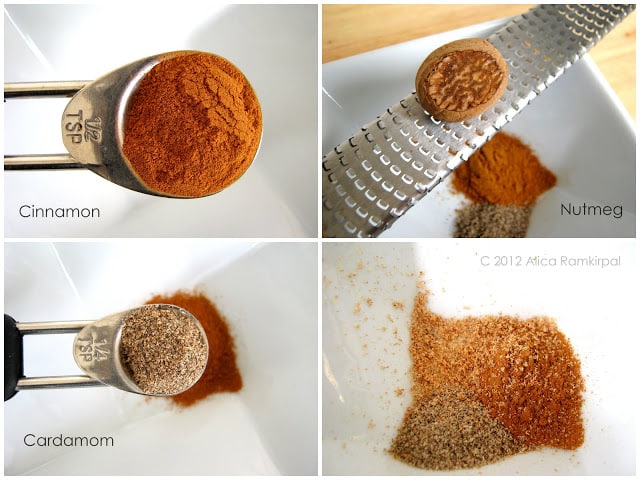
If adding cherries, chop coarsely, set aside. I used maraschino cherries, pure ghee, and one tin of evaporated milk plus 4oz more. In total 16oz evaporated milk.
Add evaporated milk, ¾ cup granulated sugar, and spices to a pot. Warm milk mixture on stove. Keep warm until ready for use.
Measure 4oz butter, 4oz ghee, and 1 cup all-purpose flour. Set aside. *You may use all butter or all ghee, this is your preference. Heat butter and ghee on medium heat until melted. Add flour and stir to dissolve.
Continue to stir until mixture thickens and forms a paste.
This is the part that will take some time and will probably give your arm a little workout. Turn heat to medium-low and stir continuously (parch) until a golden brown color is noticeable. This should take anywhere from 15-20 minutes. I would advise that you do not walk away from the stove, this mixture can burn easily which is why it is important to stir continuously until color is achieved.
I prefer to use these brands. I also use just a handful or raisins because it's not my preference, but I'll eat it. You can include golden raisins, currants, cherries, or any other addition you like.
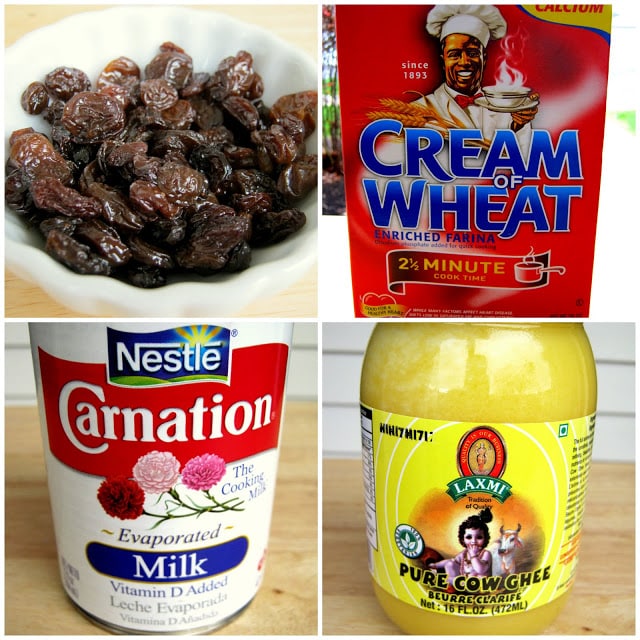
Mmm look at those wheat kernels.
Gather the same spices used for the flour-based parsad.
Add spices and this time, only ½ cup of granulated sugar to 16oz evaporated milk.
For this type of parsad, you won't need as much ghee or butter. Start with 6oz butter or ghee or 3oz of both. Melt in a pot then add flour, stir to dissolve. Add cream of wheat kernels next. Parch until mixture is golden, but not dark brown.
Add milk mixture and raisins, continue to stir until mixture is thick and pulls away from sides of pot.
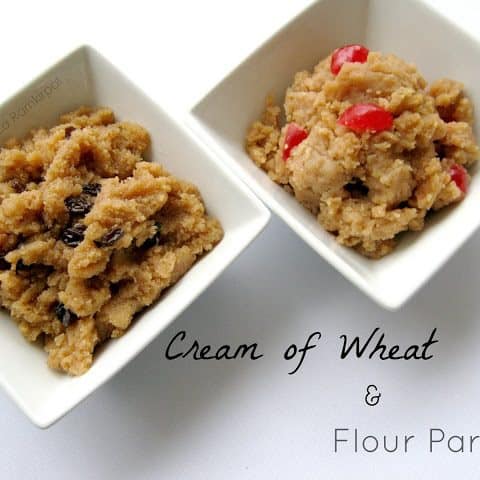
Parsad Two Ways
Ingredients
FLOUR PARSAD
- 16oz evaporated milk
- ¾ cup white granulated sugar
- ¼ teaspoon ground cardamom/elaichi
- ½ teaspoon ground cinnamon
- ⅛ teaspoon ground nutmeg
- 6-8 maraschino cherries, chopped
- 4oz ghee
- 4oz salted or unsalted butter
- 1 cup all-purpose flour
CREAM OF WHEAT PARSAD
- 16oz evaporated milk
- ½ cup white granulated sugar
- ¼ teaspoon ground cardamom/elaichi
- ½ teaspoon ground cinnamon
- ⅛ teaspoon ground nutmeg
- 2-3 tablespoon raisins
- 6oz ghee or unsalted butter
- ¾ cup cream of wheat
- ½ cup all-purpose flour
Instructions
*FLOUR PARSAD*:
- Measure 16oz evaporated milk into a small pot, add sugar and spices, stir to combine. Warm milk on stove to dissolve sugar, do not boil. Keep milk warm until ready to use.
- Heat a large pot or caharee on medium, melt ghee and butter, add flour and stir quickly to dissolve, begin parching by stirring continuously.
- Turn heat to medium-low and continue to parch flour/ghee/butter mixture until golden brown. This should take about 15-20 minutes. Do not walk away from stove, the bottom of this mixture will catch quickly to the pot and will burn.
- Once flour/ghee/butter mixture is golden brown, pour in warm milk. Stir quickly and vigorously as mixture comes together, add cherries and continue to stir.
- Parsad is done when it begins to pull away from the sides.
*CREAM OF WHEAT PARSAD*
- Measure 16oz evaporated milk into a small pot, add sugar and spices, stir to combine. Warm milk on stove to dissolve sugar, do not boil. Keep milk warm until ready to use.
- Heat a large pot or caharee on medium heat, melt ghee and butter, add flour and stir quickly to dissolve, add cream of wheat and begin parching.
- This should take about 10-12 minutes, cream of wheat kernels will begin to look brown. Do not walk away from stove, the bottom of this mixture can catch quickly to the pot and will burn.
- Add warm milk mixture and raisins, continue to stir until parsad comes together and leaves the sides of the pot.
Notes
This pudding can made in many different ways, many include peanuts, 7up soda, cream soda, orange soda, and even with eggs (commonly called sirnee). Add whatever you prefer.
Although I didn't use one here, a cast iron or caharee is commonly used to make this as it can help with achieving the brown color faster.
When adding warm milk, be sure to add slowly because it can pitch out of the pot and burn you.
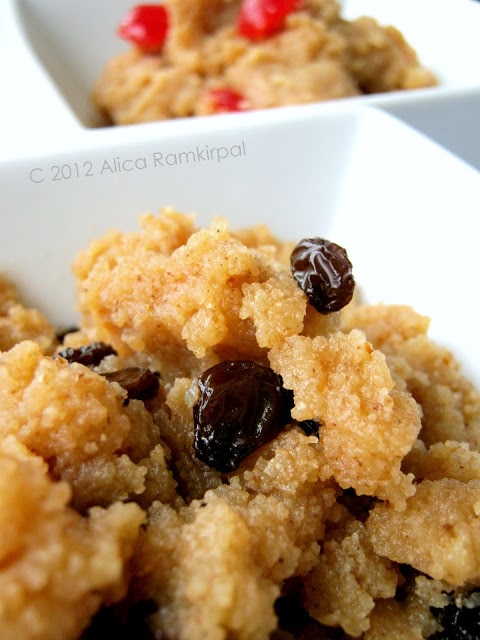


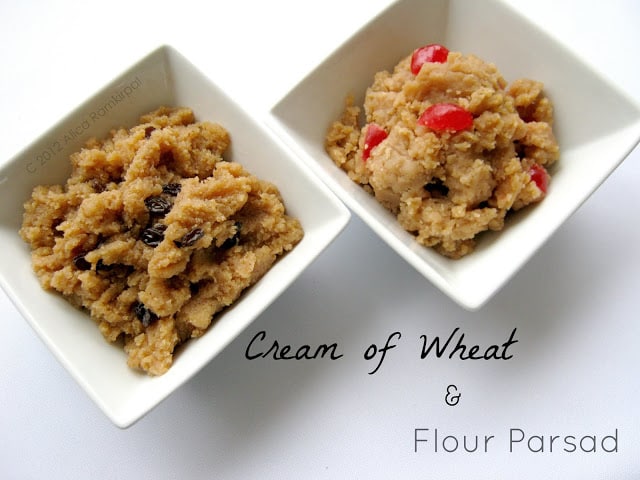
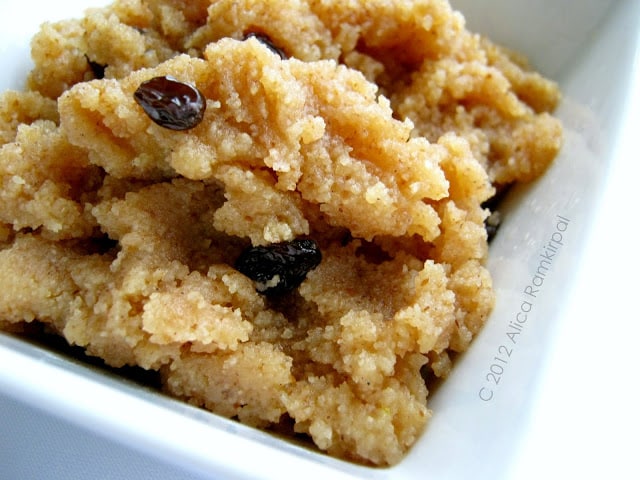
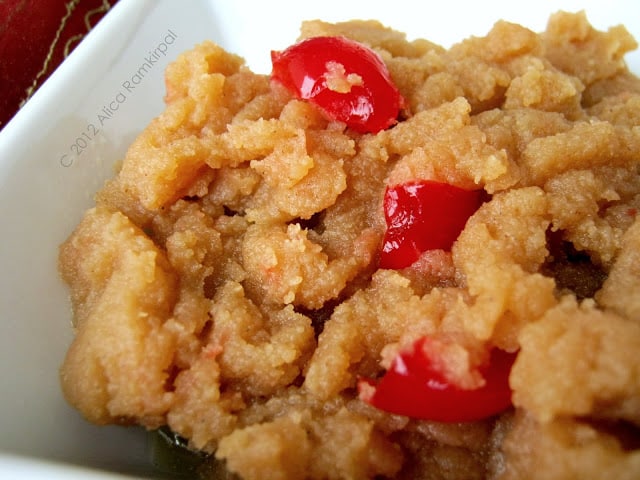
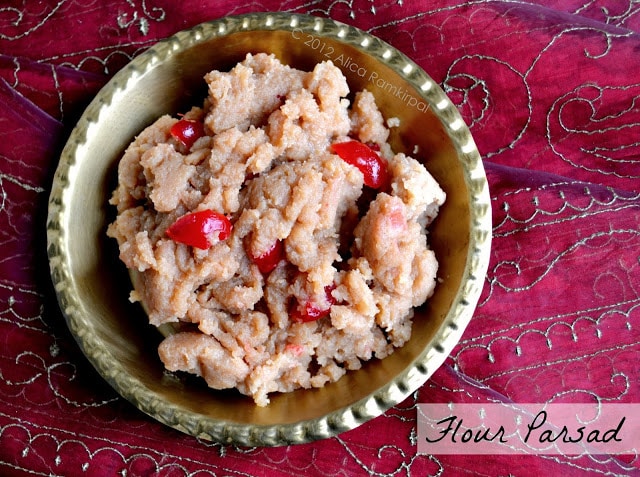
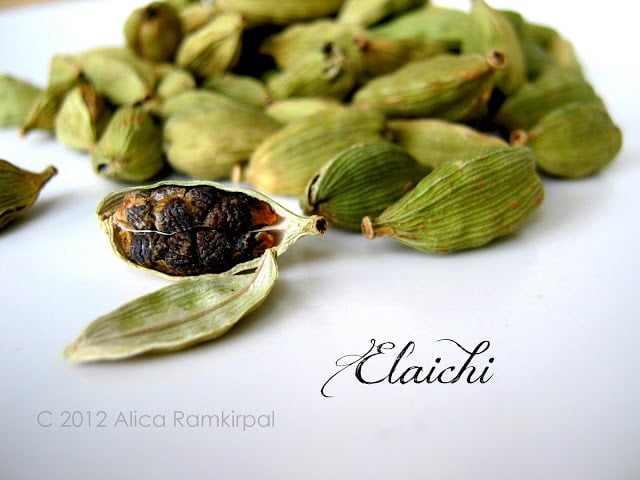
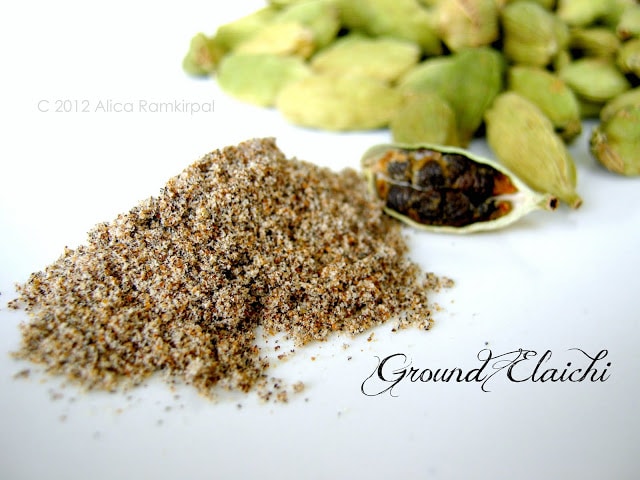
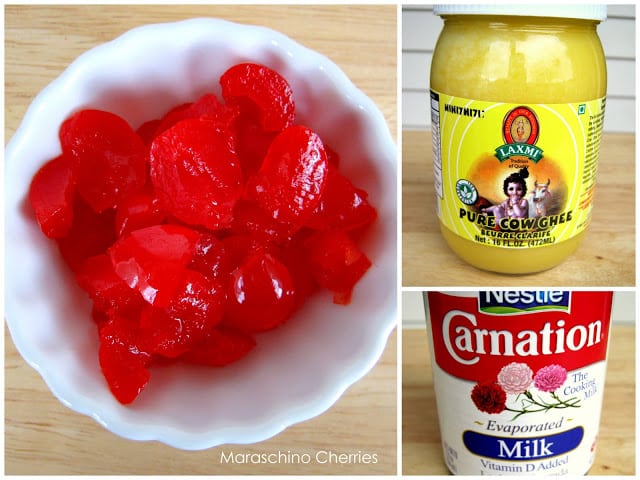
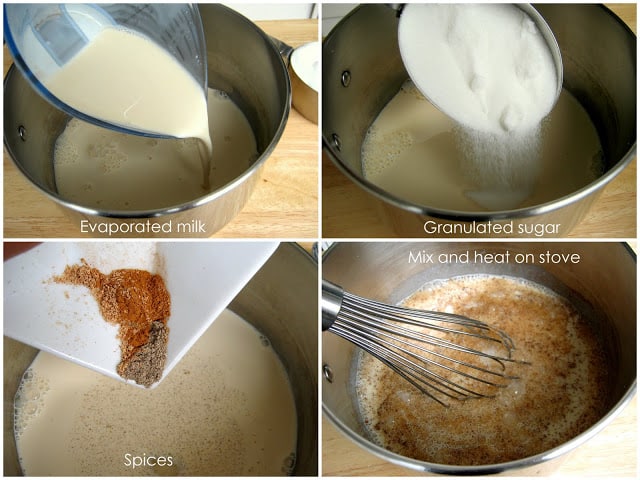
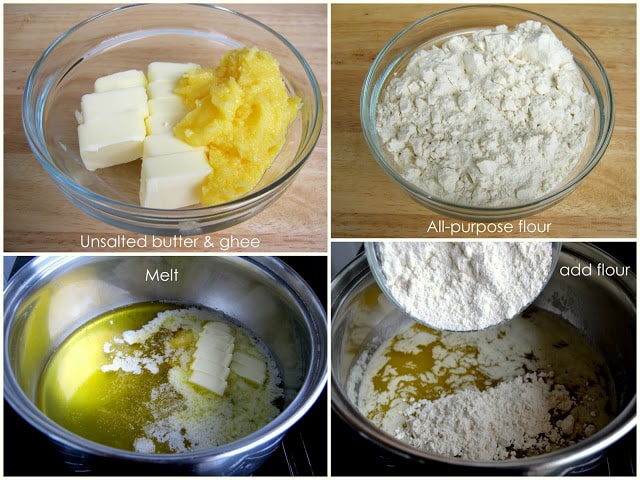
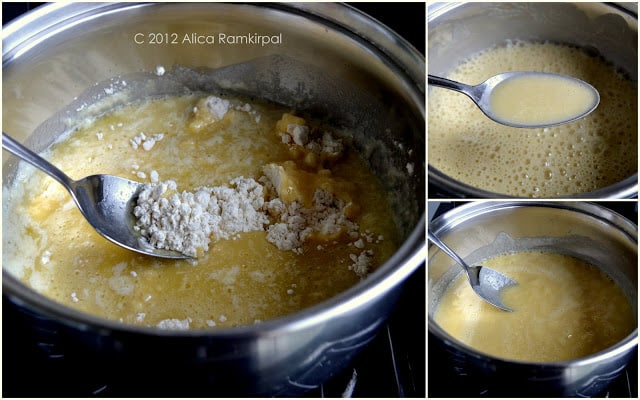
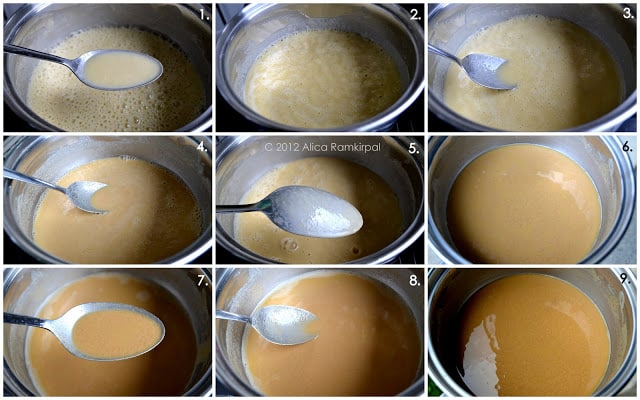
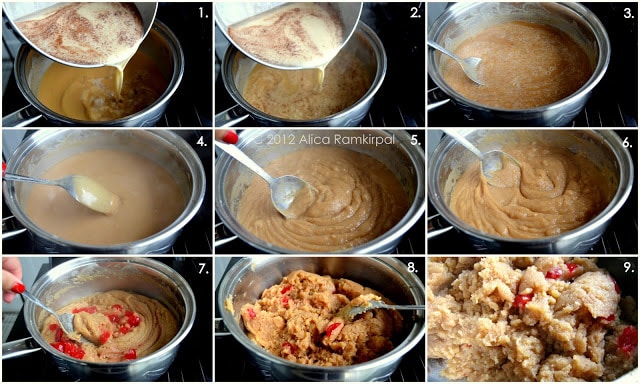
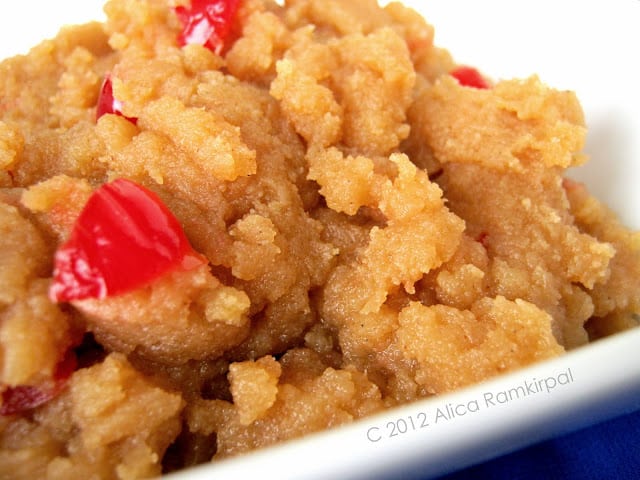
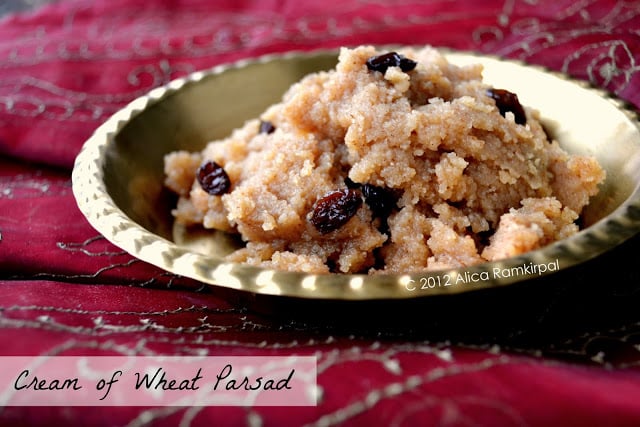
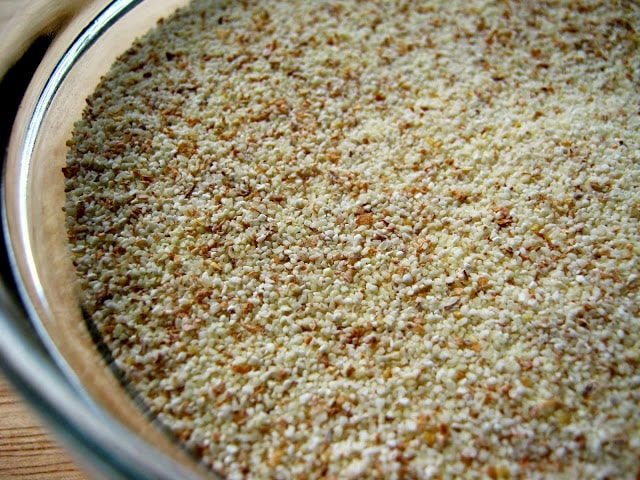
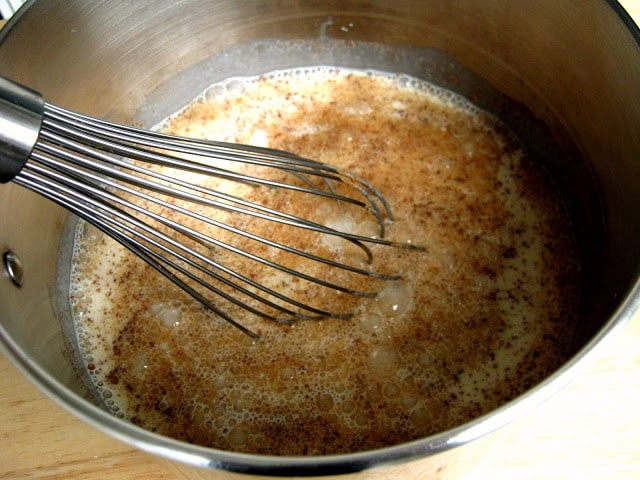
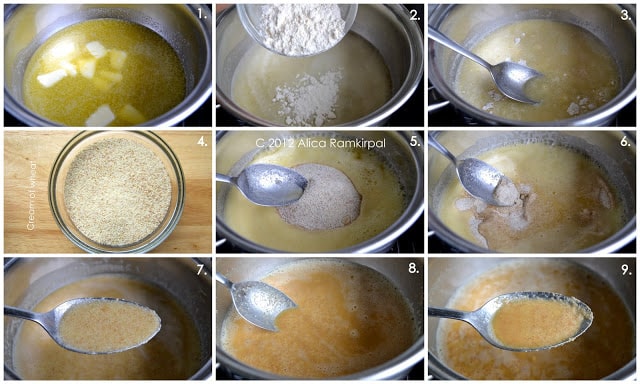
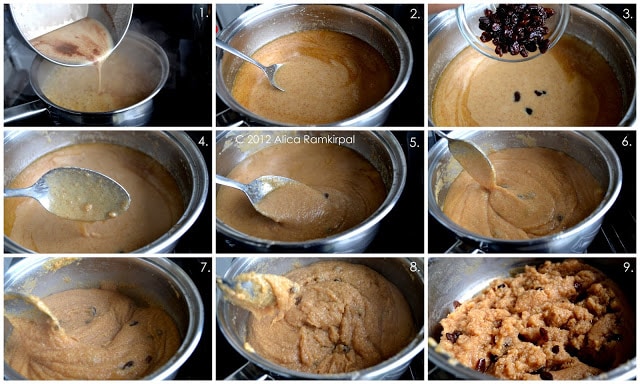
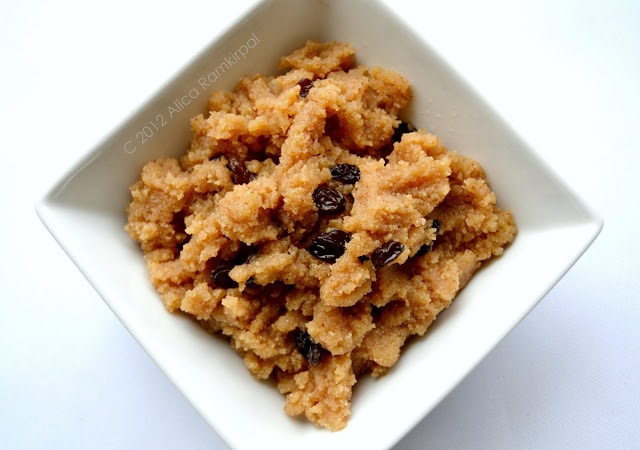
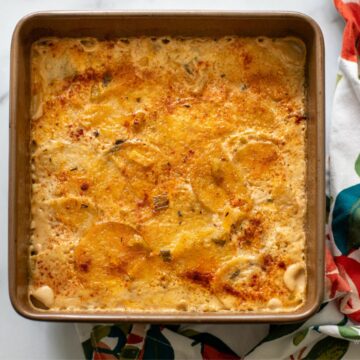
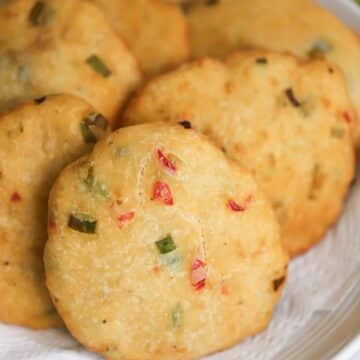
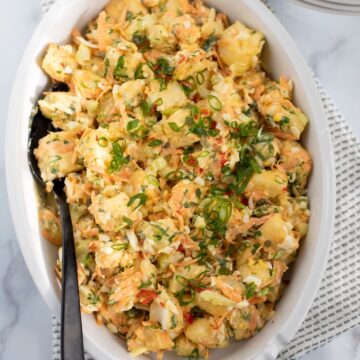
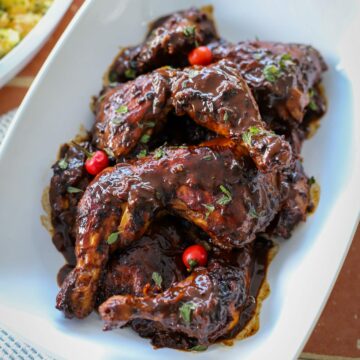
Cynthia says
Okay, there are several things to respond to here:
1. No, you are not the only person that felt that way (waiting for the goodie at the end of a jhandi (lol)
2. The second bag trio for me was parsad, roat and mitai
3. OMG - what was it with the cut up fruit, you are right, no one ate that. Okay, sometimes I might eat the banana but nothing else 🙂
4. I've never had the cream of wheat parsad
5. I applaud and appreciate the time and effort you put into to shooting step-by-step photographs.
You rock!
Del says
Ditto, ditto ladies!
Tina Beni says
If you add orange soda when do you add it and how much?
sunita says
I greatly appreciate the time and effort you spend on sharing your recipes and photos with all of us. Question: How do I adjust the recipe for 2 lbs of Flour Parsad?
Alica says
Hi Sunita,
How many people will it be serving? For 2lbs, I would probably triple this recipe.
Alica says
Hi Tina,
I haven't made it with orange soda, but I know my uncle usually does half soda, half milk, try that and see how it comes out. Hope this helps and sorry for the late reply!
sunita says
Hi Alicia, sorry for the delay in my response. Thanks for getting back to me. It will be serving 50 people.
Alica says
Hi Sunita,
You are making the flour parsad right? For, 50 people I would multiply this recipe by 4 or 5. However, I would only add about 2 cups of sugar for the flour parsad. Good luck!
sunita says
Ok great, thanks for the heads up about the sugar. Was going to multiply the ingredients by 5, now I know what to do with the sugar. Will let you know how it turns out!
sunita says
So here's my update: I used 2 sticks of butter and 1 1/2 cups of ghee. I actually made one pound of parsad instead of two. Everyone loved it, but the perfectionist in me, thinks it would've been better without any butter and perhaps 21/2 cups of ghee. Thanks again!
Alica says
Hi Sunita,
Glad to hear it turned out well. Like yourself, my mom also prefers it with just ghee, she uses only ghee especially when making it for prayers. The ghee flavor is a little strong for me, but you have to make it the way you like it :). Thanks for the update!
SSAM says
Can I just say that is my go to recipe for pujas. It is a huge hit, even my toughest critics (the in-laws) are forced to pass me a compliment when they taste it. Pure perfection. Thanks so much for sharing it. I actually do the maida version but add a hint of cream of wheat for some richness. Yummy!
Sao says
With all the wonderful reviews, i'm not pretesting - going to definitely try this Diwali 2014 [10/22] 😉 Thank you!!!
Unknown says
no sugar ..???
Alica says
The amount of sugar is listed for each version on the ingredients list.
Unknown says
I made this tonight and it was amazing! Thanks for the recipe!
Unknown says
I just made this and added some mixed nuts that I crushed a bit, came out yummy. Thank you, Diane
Christine Persad says
Alicia, thank you for posting this! I added sunkist and a few sliced almonds and it's amazing. We left our families in NY a year ago and are celebrating Diwali for the first time alone with our kids. You made this so easy for me 🙂 Thank you for sharing!!
Alica says
Hi Christine, So happy to have helped! The orange soda takes it to another level!
Amanda says
Did you use ground black cardamom or ground green cardamom?
Alica says
I believe it was the black cardamom, but either will work fine.
Janet Singh says
Hi your recipes are amazing. I made the “goja” and the “ flour parsad”. Both came out delicious.
Alica says
Hi Janet,
That's so wonderful to hear! Thanks for trying them. Hope you had a wonderful Holi!
Liz says
Can I turn leftover flour parsad into cookies or some sort of sharable dessert? I do not want it to go to waste, but I also do not want to freeze it for later.
Alica says
Hi Liz, I am sure you can find another way to use the leftovers, but I can't think of anything, so sorry!
Nik says
Leftovers? You have … leftovers? *tilts head and looks confused* 😂